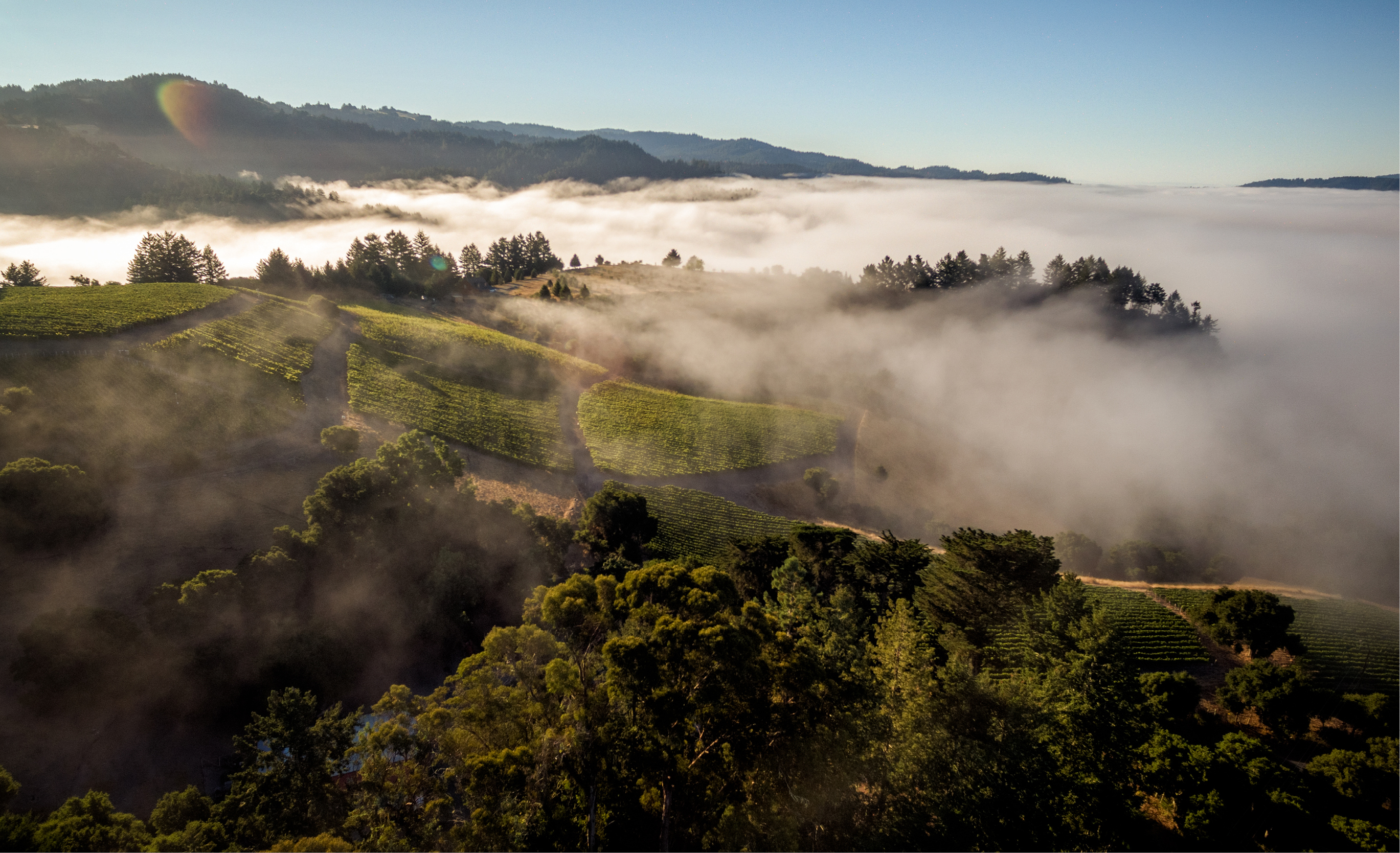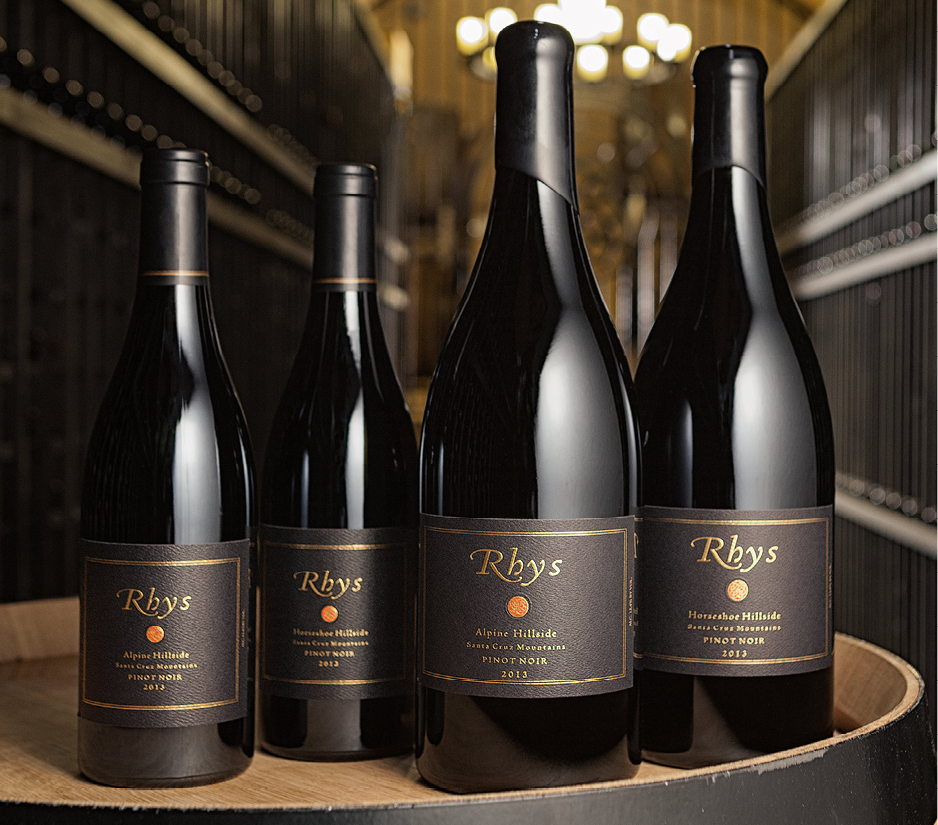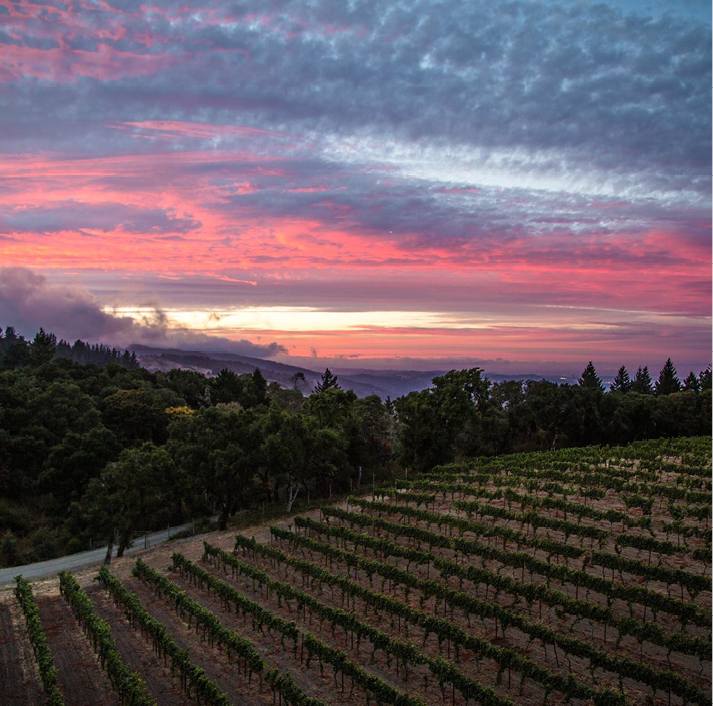Mountain Wine

By Marisa Finetti Photos by Mark Ryan
Deep in the earth’s crust, tectonic plates slide past each other, one to two inches per year. Geology and wine come together in many parts of the world, creating a profound and beautiful connection, but there’s no better place than the Santa Cruz Mountains to dig deep… and taste it.
The Santa Cruz Mountains is a wine-growing region in the shadow of technology and people. Located amid a sea of three million residents in Silicon Valley, the appellation is just a short drive south of San Francisco. How fortunate for the Bay Area to have another world-class wine region – but just a lunch hour away.
Besides the uniqueness of being flanked by the San Francisco Bay and the cool Pacific Ocean, the entire Santa Cruz wine-growing area rests where two of earth’s tectonic plates – the Pacific Plate and the North American Plate – drive activity along the famous San Andreas fault zone.
Spanning 60 miles along the California coast, the appellation is defined by its high-altitude vineyards and unique location amid the convergence of the mountains formed by the collision of these tectonic plates over 30 million years ago. This combination of steep slopes, ridgetops, and marine-cooling influences creates a patchwork of microclimates, enabling the growers and wineries to produce wines ranging from the cool-climate Pinot Noir and Chardonnay to elegant Cabernet Sauvignon, and more. For terroir-loving* wine drinkers, this is the place to discover how the soils, climate, and elevation transfer to a delicious and ingestible art form that captures the time and place we call wine.
Viewed from space, the San Andreas Fault looks like a long, narrow valley, marking where the North American plate meets the Pacific plate. But viewed up close, from Rhys Vineyards, the fault area is easily seen from the edge of the property as a scrubby ravine.
“It’s such a defining feature of the appellation,” says Jeff Brinkman, Rhys winemaker. Looking across to the North American plate, he continues to describe how it and the Pacific plate – the one we’re standing on – continues to collide.
“You can think of geology as a layer cake,” says Brinkman. “As far as we can tell, we have the most geologically diverse wine-growing region in the world, because the soils are exposed over tens of billions of years.”
In wine-growing, soil diversity is hugely advantageous, allowing grape varieties to uniquely express themselves in a relatively small area.
“We have two vineyards – 400 yards between them,” says Brinkman. They are both at the same elevation, planted with the same material, the farming and winemaking are precisely the same. The big difference is…almost 15 million years of geologic age. There is no repetition.”
Every Rhys vineyard is on a different and distinct geology from the others, but their winemaking is the same for each. The idea behind Rhys is to experiment with terroir. They limit the variable in the vineyard and winery, embrace the microclimates, and maximize expression in the wine. Imagine tasting the same wine from grapes that drive deep into the earth from different geologic times. We would expect some difference.
The team at Rhys Vineyards aspires to make great Pinot Noir and Chardonnay wines. They have searched the state for exciting rocky soils that exist within the mountainous, cool coastal climate zone. Along the fault zone surrounded by woodlands in the high elevations of the Santa Cruz Mountain range, they cultivate six estate vineyards, each of which is capable of producing uniquely compelling, distinctive, soil-driven wine.
 Rhys’ Skyline vineyard has 30-50 million-year-old soils and is incredibly diverse – a mélange of fractured mudstone, sandstone, and limestone. At over 2,300 feet in elevation, Skyline is one of the highest Pinot Noir vineyards in California. This extreme altitude helps cool the vineyard while providing the constant sunshine that is found above the fog. The rocky soils are incredibly shallow, making the vines work to dig deep. The diversity of the soils produces one of the most mineral-driven and exotic wines in the New World.
Rhys’ Skyline vineyard has 30-50 million-year-old soils and is incredibly diverse – a mélange of fractured mudstone, sandstone, and limestone. At over 2,300 feet in elevation, Skyline is one of the highest Pinot Noir vineyards in California. This extreme altitude helps cool the vineyard while providing the constant sunshine that is found above the fog. The rocky soils are incredibly shallow, making the vines work to dig deep. The diversity of the soils produces one of the most mineral-driven and exotic wines in the New World.
Yet another vineyard, the Alpine Vineyard, gazes at the Pacific Ocean located 10 miles in the distance. From its steep and rocky perch, the four-million-year-old, chalky and sedimentary bedrock of the Purisima Formation soils are shallow and rocky. The altitude and proximity to the ocean contribute to a cool climate. At Alpine Vineyard, half-acre blocks contain 16 different selections of Pinot Noir and four different selections of Chardonnay. Each of these Pinot Noirs offer the unusual combination of rich black fruit and crushed rock complexity that makes this vineyard distinct from other vineyards, while the Chardonnay showcases a combination of coiled energy in a glass with fine marine saline complexity.
Being able to taste the difference from uniquely different parcels allows a deep dive into how terroir affects the wine. When one has two glasses, the only thing better – besides enjoying the aromas and taste – is to experience the difference of where they are from.
And still more is to be discovered in the Santa Cruz Mountains. This time, looking across the fault zone to the east, is the North American plate where the acclaimed Ridge Vineyards sits.
“We are actually on the edge of North America,” says Eric Baugher, COO and winemaker of Ridge Monte Bello. Looking back at Rhys Vineyards, the ravine of conifers and overgrown brush cover an assemblage of ancient oceanic crust material of sandstone, shale, and clay, known as Franciscan Complex, have been churned and exposed over millions of years.
However, Ridge’s vines penetrate a subsoil of a slightly different kind – limestone, which is rare in California and somewhat of an anomaly in the Bay Area. This mountain, on which it stands, was dragged by another ancient plate, the Farallon Plate, which laid between the converging North American and Pacific Plates. The limestone and greenstone mélange formed 140-160 million years ago as a seamount on the Farallon tectonic plate.
“It hit North America, shaved off, and left this mound right here,” says Baugher.
The mix lifted to form the Monte Bello Ridge through seismic upheaval from the adjacent San Andreas Fault. The limestone is said to help sweeten the soil, buffering the effects of acidic rain and helping the grapes retain their acidity. The fractured rocks allow for good drainage, and for the vine roots to penetrate deep into the rock, searching for water.
Cabernet Sauvignon, Cabernet Franc, and Merlot excel in the limestone-influenced soils throughout all four ranches at Monte Bello, especially in more exposed sites where the soil is more weathered. These lean soils temper the vigor of Cabernet Sauvignon, producing intense and structured wines that continue to win the world over.
A great amount of complexity and diverse “nurturing” of the vines from different geological eras consequently showcase characteristics in the finished wine. It is also reasonable to say the wines of the Santa Cruz Mountains is in a constant state of energized motion – just as the plates are continuously moving and rubbing against each other, churning up rocks and soil in the process.
Those who are aware of Santa Cruz mountain wines have fully engaged palates. They are lovers of coastal influences, high elevation, and cool-weather wines. Wines of energy.
From the majestic Redwoods to the rugged Pacific coastline, Santa Cruz Mountains are home to some of the world’s most passionate wine producers making magic along this geologic wonder.
* Terroir (/ter’wär/) is the French term describing all of the environmental factors which can affect a crop’s taste, color, etc.
VISITOR’S GUIDE
Bring Your Surfboard & Your Wine Opener
Salty ocean waves. Nature hikes with stunning views. Ziplining through the redwoods. Charming towns. The Santa Cruz Mountains are a place where everyone can play. All that’s required is a sense of exploration.
GET THERE
Fly into San Jose and rent a car
STAY
Chaminade Resort & Spa
Situated on the northwestern edge of scenic Santa Cruz, Chaminade is a mountaintop resort featuring newly renovated accommodations and breathtaking views of Monterey Bay and the Santa Cruz Mountains. Lounge amidst lush green trees and the resort’s historic Mission-style design. Guests can indulge in fresh California Cuisine or experience a revitalizing spa treatment.
EAT
The Bywater
A casual, New Orleans-inspired restaurant in Los Gatos offers raw oysters, gumbo ya-ya, po’boy or fried chicken, and an amazing wine list. thebywaterca.com
Plumed Horse
Under Head Chef Peter Armellino’s leadership, Plumed Horse presents elegant, modern California Cuisine, emphasizing what is fresh, seasonal, and sustainably produced. Plumed Horse has been awarded a Michelin Star.
DRINK (WINERIES)
Mount Eden Vineyards
Mount Eden Vineyards is a small historic wine estate perched at 2,000 feet overlooking Silicon Valley in the Santa Cruz Mountain Appellation. Founded in 1945, it is recognized as one of the original “boutique” California winery properties, focusing on small lots of Pinot Noir, Chardonnay, and Cabernet Sauvignon. mounteden.com
Sante Arcangeli Family Wines
Sante Arcangeli Family Wines carefully handcrafts Burgundian varietals that have been gently nurtured from rare mountain-grown fruit to a new life as elegant and expressive California Pinot Noir and Chardonnay. santewinery.com
Ridge Vineyards
Critically acclaimed for more than six decades, Ridge is one of the most well-known Santa Cruz Mountains wineries and steeped in rich history. The Ridge Monte Bello Cabernet beat out acclaimed French wines in the legendary 1976 Judgment of Paris, garnering acclaim for the region and California wines in general. In the 2006 re-tasting, the same wine earned 1st place. Ridge focuses on a minimal intervention approach and has been championing single vineyard winemaking since its inception. ridgewine.com
Eden Estate
Eden Estate is located in an eastern valley at the base of Mt. Eden. Winemaker Bill Brosseau produces a premium Cabernet Sauvignon from the two and a half acres of hand-harvested fruit grown organically on the property. edenestatewines.com
Thomas Fogarty Winery
From the beginning, it was the vision of Thomas Fogarty Sr. that when the winery and 30-acre vineyard was developed, the remaining 330 acres from his 360-acre estate would be set aside to remain an open space preserve. Using organic, sustainable, and biodynamic practices, with a healthy touch of intuition, they have developed Chardonnay and Pinot Noir in the cool Northern Skyline sub-region of the Santa Cruz Mountains for the past 35 years. fogartywinery.com
Mindego Ridge
Mindego Ridge is a small 10-acre Santa Cruz Mountains vineyard perched on a south facing, shale-laced slope 8 miles from the Pacific, lovingly farmed and cared for by husband and wife owners, David & Stacey Gollnick. Their mission is to produce 100% estate grown, single vineyard Pinot Noir and Chardonnay that authentically express the marine-influenced mountain terroir. Wines are crafted in small lots, with minimal intervention, by cool-climate virtuoso, Ehren Jordan. Mindegoridge.com

